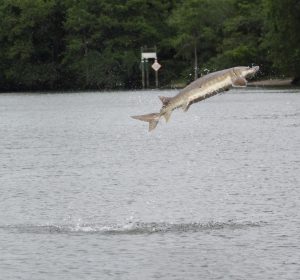
Years ago, we took a family canoe trip down the Suwannee River. It’s a gorgeous place to paddle, with cypress draping over the banks and crystal-clear springs feeding into the main channel. At one point, we heard a splash that sounded like a grown man had belly-flopped from a 20-foot diving board into the water. There were no bridges or rope swings in the vicinity, though, and we quickly realized we’d heard a Gulf sturgeon (Acipenser oxyrinchus desotoi) jumping. These fish are considerably larger than a grown man, with females of the species growing up to 8’ long and over 200 pounds.
The Suwannee has the highest concentration of these dinosaurs of the fish world, with current population estimates at 10,000 individuals. Water quality and habitat in this particular river are excellent, with no dams and a “wild” quality not seen in many other places.

Their ancestors have been living in the Gulf and nearby rivers for 200 million years, and individual fish often have lifespans 25 years or more. Between the late 1800s and early 1980’s, commercial sturgeon fishing, particularly for their eggs, or roe, as caviar, was common. Unfortunately, fish were taken from the rivers at such an unsustainable rate that the population was nearly wiped out. The state of Florida began protecting the fish in 1984, and seven years later the sturgeon landed on the federal endangered species list. Since that time, sturgeon populations have been monitored in the rivers along the northern Gulf, from coastal Mississippi to Apalachicola. In Florida, the Fish and Wildlife Conservation Commission (FWC) manages a catch and release tagging program. Biologists weigh, measure, take DNA samples, and tag sturgeon to monitor the health of the population.

Sturgeon are anadromous fish, which means they live and feed out in the Gulf of Mexico and associated bays, but swim upstream to freshwater rivers to spawn. Interestingly, the only time they eat is during their winter residence in the saltwater. They bulk up, increasing size by 50%, but survive only from their muscle and fat stores during the spring and early fall while spawning in the rivers.

Sturgeon are unusual for other reasons, too—being an early-evolving fish species, they are protected by an external skeleton of bony plates called scutes. They have neither an internal skeleton nor teeth, and have mouths resembling rays and skates. To feed, they extend their mouthparts and use a strong suctioning force to take in bottom-dwelling prey. They also have highly sensitive barbels, like catfish, to detect movement in the muddy bottom. When young, they eat small aquatic invertebrates, but as they grow, they’ll eat shrimp, crabs, and worms. The largest reported sturgeon was found at the mouth of the Mississippi River in the 1930s, weighing in at 503 pounds. While males are large, females are larger to accommodate their enormous egg masses. Each spawning cycle, a female fish can produce anywhere from 200,000-500,000 eggs.

Like mullet, sturgeon are known for leaping out of the water. What purpose does this serve, especially for such a large fish? After years of pondering, biologists have realized it’s all about maintaining buoyancy. As large fish that spend most of their time just off the bottom, it’s important for them to have the right level of flotation. By jumping well out of the water, the fish gulp in air, which refills their swim bladders and allows them to adjust to the right depth. As you can imagine, being in a boat in the path of a 200-pound animal leaping high into the air can be dangerous. FWC has been trying to educate boaters and paddlers how to be extra careful in areas known for high concentrations of sturgeon, particularly in the Suwannee River.
I recently attended a public showing of a short film called “Gentle Giant: The Mystery of the Sturgeon.” It includes old photographs of the early commercial fishery and follows the fishes’ story up to current times, with footage of sturgeon jumping and biologists wrangling the massive specimens into boats for data collection. The film is published by the US Fish and Wildlife Service and is available to watch for free on YouTube. I highly recommend it—the story of the sturgeon and its comeback is an inspiring one.
 7
7
